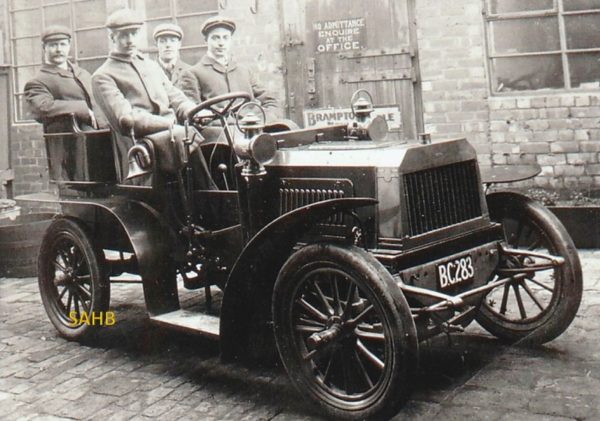
Well, more like AD1905, give or take another year. ‘BC’ was the Leicester CBC registration mark: no records survive there. This series ended in June 1925, to be followed by ‘RY’, so perhaps late 1905 or early 1906 would be a fair guess at the date of issue for BC283.
Those of us who enjoy studying period photographs of early motor cars like to attempt to identify the make, and maybe even model, of the car pictured, taking in such pointers of specification as can be seen, as well as savouring the period atmosphere recorded in these now-ancient images. Collectors of these photographs, usually filed alphabetically by make of car, tend to have a small number of ‘unknowns’, and great is the jubilation when the subject of prolonged pondering can finally be christened. In this case, identification remains unsolved, and in one sense that adds to its interest. In the early days, many cars were registered with an authority where the manufacturer was located. Whilst not far from the main centres of Coventry and Birmingham, Leicester’s sole, even slightly significant marque was the Clyde car, and BC283 shows no similarity.
A home built, one-off or much-modified vehicle poses obvious problems but amateurish features seen in such cases often lead to that conclusion. The overall appearance of BC283 on the other hand is of a well-made vehicle from an established manufacturer that shows an integrated design, and quality coachwork is in place. Identification normally begins with the radiator, here well-made with a very small oval badge centrally on the header tank. Vertical copper or maybe gilled tubes form the cooling element. Many makers showed no fixation to any one style in the early days. This angular, rather squat shape was used briefly by Maudslay, Horbick, Napier and doubtless others, but no close match has emerged.
What can we see of the specification? The size of the car and the bonnet length suggest a twin-cylinder engine: possibly even a ‘four’ lies within. Those proportions suggest a 10 or 12hp engine size. The car is shaft drive with a live rear axle, and the quadrant gear-change seems to be supplemented by a separate ball-headed lever for reverse gear. Five-spoked steering wheel; not that uncommon; both wheel and column seem free from levers and additional hand controls. Armoured wood main frame to which those spidery dumb-irons would have been bolted. Forward-placed track rod – again, not really unusual. The front wheel hubs project a very long way, a feature shared by contemporary Mors and Napier cars; maybe others, too.
Two final points before the mystery is thrown open to knowledgeable readers. The starting-handle is set very low and it is unlikely that it could connect directly to the forward end of the crankshaft – maybe sprockets and a roller-chain intervened: the clearance from the track-rod for swinging the handle appears to be barely adequate. Secondly, the mudguards and small running-board do not seem to ‘belong’. The latter is very low set and non-functional. I’d suggest that these items are non-original.
Text and picture by John Warburton







Leave a Comment